Paper Menu >>
Journal Menu >>
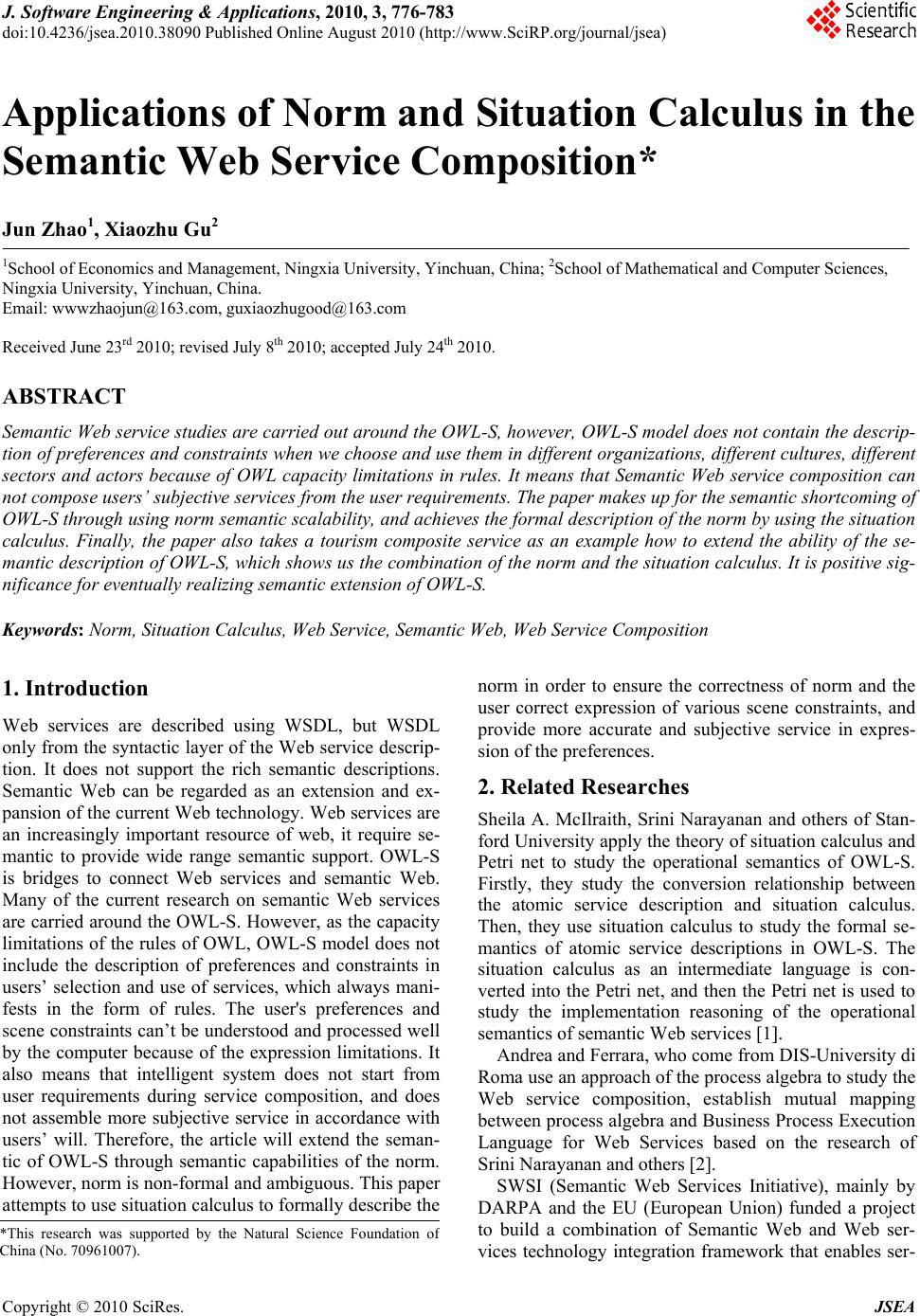 J. Software Engineering & Applications, 2010, 3, 776-783 doi:10.4236/jsea.2010.38090 Published Online August 2010 (http://www.SciRP.org/journal/jsea) Copyright © 2010 SciRes. JSEA Applications of Norm and Situation Calculus in the Semantic Web Service Composition* Jun Zhao1, Xiaoz hu Gu2 1School of Economics and Management, Ningxia University, Yinchuan, China; 2School of Mathematical and Computer Sciences, Ningxia University, Yinchuan, China. Email: wwwzhaojun@163.com, guxiaozhugood@163.com Received June 23rd 2010; revised July 8th 2010; accepted July 24th 2010. ABSTRACT Semantic Web service studies are carried out around the OWL-S, however, OWL-S model does not contain the descrip- tion of preferences and co nstraints when we ch oose and use them in differen t organization s, different cultures, different sectors and actors because of OWL capacity limitations in rules. It means that Semantic Web service composition can not compose users’ subjective services from the user requirements. The paper makes up for the semantic shortcoming of OWL-S through using norm semantic sca lability, and achieves th e formal de scription of the norm by us ing the situa tion calculus. Finally, the paper also takes a tourism composite service as an example how to extend the ability of the se- mantic description of OWL-S, which shows us the combination of the norm and the situation calculus. It is positive sig- nificance for even tually realizing semantic extension of OWL-S. Keywords: Norm, Situation Calculus, Web Service, Semantic Web, Web Service Composition 1. Introduction Web services are described using WSDL, but WSDL only from the syntactic layer of the Web service descrip- tion. It does not support the rich semantic descriptions. Semantic Web can be regarded as an extension and ex- pansion of the current Web technology. Web services are an increasingly important resource of web, it require se- mantic to provide wide range semantic support. OWL-S is bridges to connect Web services and semantic Web. Many of the current research on semantic Web services are carried around the OWL-S. However, as the capacity limitations of the rules of OWL, OWL-S model does not include the description of preferences and constraints in users’ selection and use of services, which always mani- fests in the form of rules. The user's preferences and scene constraints can’t be understood and processed well by the computer because of the expression limitations. It also means that intelligent system does not start from user requirements during service composition, and does not assemble more subjective service in accordance with users’ will. Therefore, the article will extend the seman- tic of OWL-S through semantic capabilities of the norm. However, norm is non-formal and ambiguous. This paper attempts to use situatio n calculus to formally describ e the norm in order to ensure the correctness of norm and the user correct expression of various scene constraints, and provide more accurate and subjective service in expres- sion of the preferences. 2. Related Researches Sheila A. McIlraith, Srini Narayanan and others of Stan- ford University apply the th eory of situation calculus and Petri net to study the operational semantics of OWL-S. Firstly, they study the conversion relationship between the atomic service description and situation calculus. Then, they use situation calculus to study the formal se- mantics of atomic service descriptions in OWL-S. The situation calculus as an intermediate language is con- verted into the Petri net, and then the Petri net is used to study the implementation reasoning of the operational semantics of semantic Web services [1]. Andrea and Ferrara, who come from DIS-University di Roma use an approach of the process algebra to study the Web service composition, establish mutual mapping between process algebra and Business Process Execution Language for Web Services based on the research of Srini Narayanan and others [2]. SWSI (Semantic Web Services Initiative), mainly by DARPA and the EU (European Union) funded a project to build a combination of Semantic Web and Web ser- vices technology integration framework that enables ser- *This research was supported by the Natural Science Foundation o f China (No. 70961 0 0 7).  Applications of Norm and Situatio n Calcu lus in the Semantic Web Service Composition 777 vice providers and service requesters in the service dis- covery retrieval, matching, call, monitor and so on to achieve the greatest possible integration of automation and dynamic. Yongshang Cheng and Zh ijian Wangf, who come fro m College of Computer and Information Engineering, He- hai University have invented formal model of semantic Web services on the basis of colored Petri nets [3] .They formally describes several basic web service composition models in OWL-S, which is constructed to meet the de- mand of service, but it lacks of the expression of services semantic information. Jun Liao, Hao Tan and Jinde Liu, who come from the University of Electronic Science and Technology, de- scribe the Web service composition by using Pi calculus. The paper introduces an example using Pi calculus to describe the Web service composition [4]. From the above research and projects we can see that researchers have made some valuable results in the se- mantic Web and Web service composition context, and many research problems wait to be solved to provide more powerful semantics services especially in the se- mantic extensions, but the theoretical system of service composition engineering and implementation technology are still immature because the study of history is not long. This paper introduces norm theory of Organizational Semiotics to solve th e problem of semantic deficiency in Web service composition. In order to achieve a deeper level of semantic extension, it achieves the formal de- scription of norm in semantic expansion by the theory of situation calculus in order to ensure the accuracy of se- mantic extension. 3. Applications of Norm and Situation Calculus in the Semantic Web Service Composition Norm is also known as social norms which is the com- mon rules of conduct and standards of every member in a social group or smaller groups, which is in the Oxford Encyclopedia of the explanation. As rules in expression limitations of the OWL, OWL-S model does not include the users’ the description of preferences and constraints in the selection and use of services. It try to introduce norm to provides a new th eo- retical platform in the se mantic Web service compositio n in order to solve Web services Semantic shortage de- scribed by the OWL-S in the semantic Web service composition. This approach considers many the users’ initiative and willingness. It joins the human factor in the service composition to provide a more personalized composition services. Norm determines whether and when an event occurs, and also decided meeting the particular needs should call the areas of service layer of what services. It can describe the activities relationship of the system control. The norm detailed description includ es the following sections [5]. Whenever< Conditions set >If< State Sets >Then <Agent>Is <Deontic Operator>To< Action sets >Con- sequence< Result Sets> Conditions Sets specified the conditions when an Agent executed an act. Further instructions can be speci- fied by If < State set>, which show that it happened in what state. <Agent> Refers to the responsibility Agent, Agent may be people here, also may be software. < De- ontic logic operators> including allowing (Permitted), must (Obliged), prohibition (Prohibited)etc. <Action Sets> determined action sets applied in the case of cond i- tions to met for Agent. <Result sets> is the results after the successful implementation of the specification, which is also the goals of users implement the act. We can see that norm is different from the relations of causality [6]. Causality is usually on ly a brief description, if the conditions are met, then certain beh avior co uld take place. Therefore causality is rigid and limited, and there is not available for human decision. On the contrary, norms are a better reflection of how people activities in the business environment. Therefore it is more suited to the description of user needs in the real business. Changes of user needs in the growing environment can be described through the norm. This required model can fully focus on changes factors. It will help to provide dynamically alternative solutions among the service layer and process layer on us er needs. Situation Calculus is a multi-type and first-order logic language, and has some second-order characteristics. It is a formal planning approach and describes a logical basis for dynamic system. For problem solving of the dynamic field and logic programming, it is first proposed in 1963 by McCarthy who is the master of artificial intelligence. Goal-oriented autonomous behavior reasoning can be carried out in a dynamic environment by situation calcu- lus. In the situation calculus, a scenario is a snapshot of the world, and dynamic changes in the world are all the result of actions. Scenarios class is applied to express Situation Calculu s, and the scene change is th e results of the actions. In ontology, the action is the basic means to change the state of things. Therefore, a possible world active can be viewed as a string of action series. Situation calculus constitutes by the following three elements: ac- tion, situation and fl ow. Action is the basic means to change station of things. All Changes in the state of things are the result of the implementation of the action sequences. A specific pre- dicate Pos s is used to indicate that an action is executa- ble. Situation is the dynamic world. All changes in the world are the result of action, which is a string of limited action sequences. Action function is expressed as: action Copyright © 2010 SciRes. JSEA 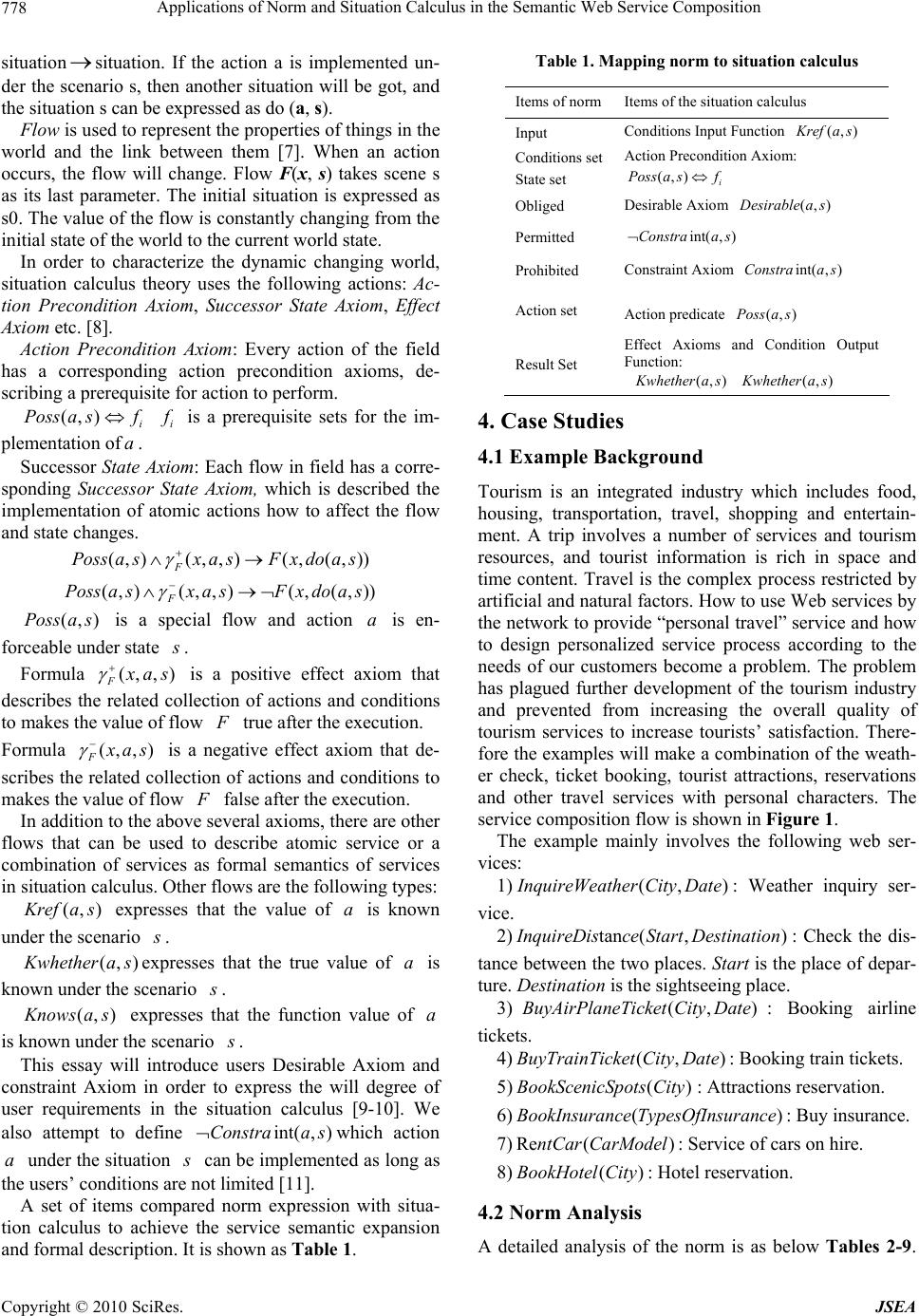 Applications of Norm and Situatio n Calcu lus in the Semantic Web Service Composition Copyright © 2010 SciRes. JSEA 778 Table 1. Mapping norm to situation calculus situationsituation. If the action a is implemented un- der the scena rio s, th en anothe r situa tion will b e got, an d the situation s can be expressed as do (a, s). Items of normItems of the situation calculus Input Conditions Input Function (,) K refa s Conditions set State set Action Precondition Axiom: (,) i Possa sf Obliged Desirable Axiom (,) D esirable a s Permitted int( , )Constraa s Prohibited Constraint Axiom int( , )Constraas Action set Action predicate ( , )Possa s Result Set Effect Axioms and Condition Output Function: (,) K whether as (,) K whether as Flow is used to represent the properties of thin gs in the world and the link between them [7]. When an action occurs, the flow will change. Flow F(x, s) takes scene s as its last parameter. The initial situation is expressed as s0. The value of the flow is constantly changing from the initial state of the world to the current world state. In order to characterize the dynamic changing world, situation calculus theory uses the following actions: Ac- tion Precondition Axiom, Successor State Axiom, Effect Axiom etc. [8]. Action Precondition Axiom: Every action of the field has a corresponding action precondition axioms, de- scribing a prerequisite for action to perform. (,)i Poss asf i f is a prerequisite sets for the im- plementation of. a4. Case Studies 4.1 Example Background Successor State Axiom: Each flow in field has a corre- sponding Successor State Axiom, which is described the implementation of atomic actions how to affect the flow and state changes. Tourism is an integrated industry which includes food, housing, transportation, travel, shopping and entertain- ment. A trip involves a number of services and tourism resources, and tourist information is rich in space and time content. Travel is the complex process restricted by artificial and natural factors. How to use Web services by the network to provide “personal travel” service and how to design personalized service process according to the needs of our customers become a problem. The problem has plagued further development of the tourism industry and prevented from increasing the overall quality of tourism services to increase tourists’ satisfaction. There- fore the examples will make a combination of the weath- er check, ticket booking, tourist attractions, reservations and other travel services with personal characters. The service composition flow is shown in Figure 1. (,)(,,)(, (,)) F Possasxas Fxdoas (,)(,,)(,(,)) F Poss asxasFxdoa s (,)Poss a s is a special flow and action is en- forceable under state a s . Formula (,,) F x as is a positive effect axiom that describes the related collection of actions and conditions to makes the value of flow F true after the execution. Formula (,,) F x as is a negative effect axiom that de- scribes the related collection of actions and conditions to makes the value of flow F false after the execution. In addition to the above several axioms, there are other flows that can be used to describe atomic service or a combination of services as formal semantics of services in situation calculus. Other flows are the following types: The example mainly involves the following web ser- vices: 1) (, ) I nquireWeather CityDate: Weather inquiry ser- vice. (,) K refa s expresses that the value of is known under the scenario a s . 2) tan (,) I nquireDisce StartDestination: Check the dis- tance between the two places. Start is the place of depar- ture. Destination is the sightseeing place. (,) K whethera sexpresses that the true value of is known under the scenario a s . 3) : Booking airline tickets. (,BuyAirPlaneTicket CityDate) ) ) ) (,) K nows as expresses that the function value of is known under the scenario a s . 4) : Booking train tickets. (,BuyTrainTicket CityDate This essay will introduce users Desirable Axiom and constraint Axiom in order to express the will degree of user requirements in the situation calculus [9-10]. We also attempt to define which action under the situation int( , )Constraa s a s can be implemented as long as the users’ conditions are not limited [11]. 5) : Attractions reservation. (BookScenicSpots City 6) : Buy insurance. ()BookInsurance TypesOfInsurance 7) Re : Service of cars on hire. ( )ntCar CarModel 8) : Hotel reservation. (BookHotel City A set of items compared norm expression with situa- tion calculus to achieve the service semantic expansion and formal description. It is shown as Table 1. 4.2 Norm Analysis A detailed analysis of the norm is as below Tables 2-9. 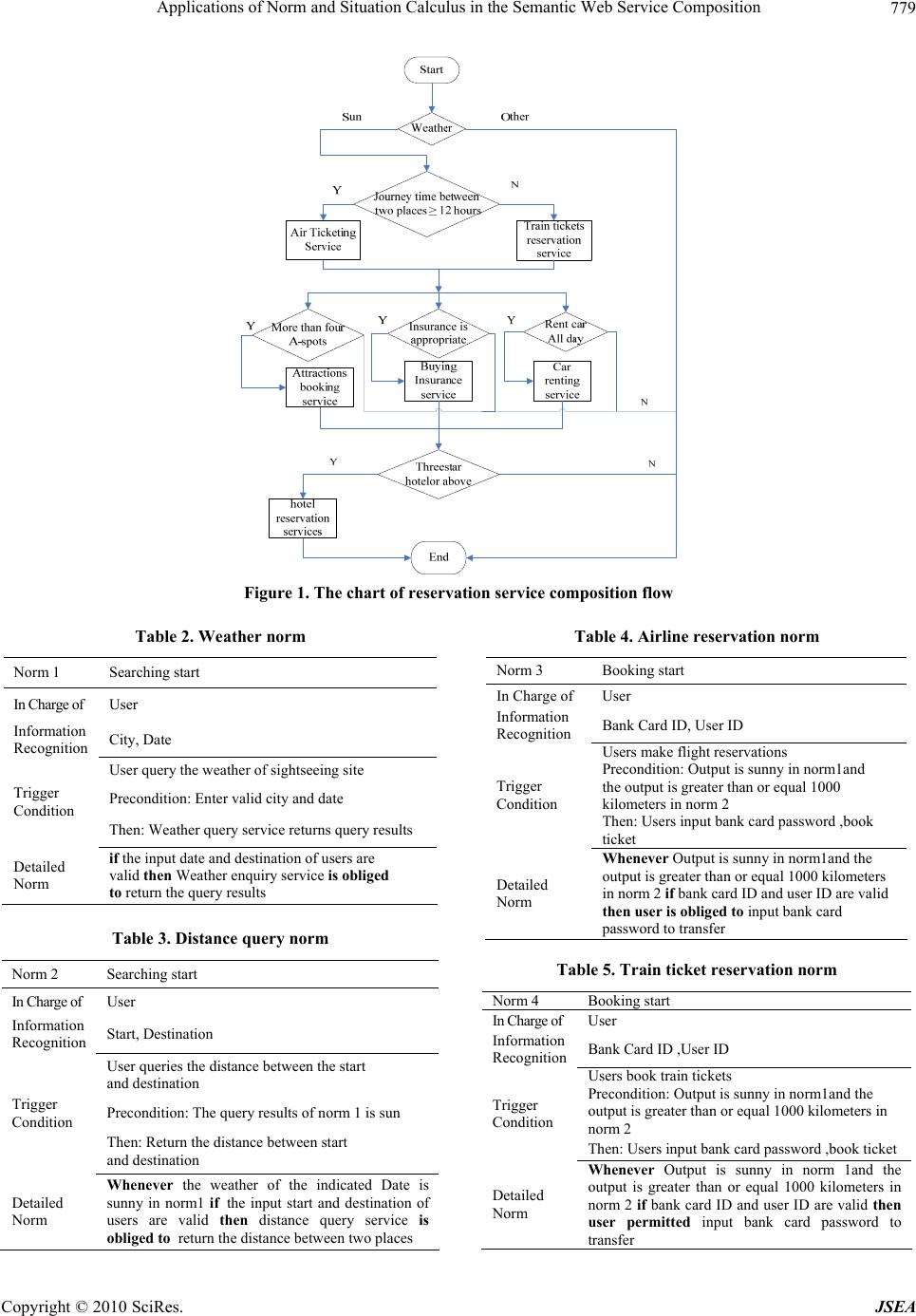 Applications of Norm and Situatio n Calcu lus in the Semantic Web Service Composition 779 Figure 1. The chart of reservation service composition flow Table 2. Weather norm Norm 1 Searching start In Charge of User Information Recognition City, Date User query the weather of sightseeing site Precondition: Enter valid city and date Trigger Condition Th en: Weather query service returns query results Detailed Norm if the input date and destination of users a re valid then Weather enquiry service is obliged to return the query results Table 3. Distance query norm Norm 2 Searching start In Charge of User Information Recognition Start, Destination User queries the distan ce between the start and destination Precondition: The query results of norm 1 is sun Trigger Condition Then: Return the distance between start and destination Detailed Norm Whenever the weather of the indicated Date is sunny in norm1 if the input start and destination of users are valid then distance query service is obliged to return the distance between two places Table 4. Airline reservation norm Norm 3 Booking start In Charge of User Information Recognition Bank Card ID, User ID Users make flight reser vati on s Precondition: Output is sunny in norm1and the output is greater than or equal 1000 kilometers in norm 2 Trigger Condition Then: Users input bank card password ,book ticket Detailed Norm Whenever Output is sunny in norm1and the output is greater than or equal 1000 kilometers in norm 2 if bank card ID and user ID are valid then user is obliged to input bank card password to transfer Table 5. Train ticket reservation norm Norm 4 Booking start In Charge of User Information Recognition Bank Card ID ,User ID Users book train tickets Precondition: Output is sunny in norm1and the output is greater than or equal 1000 k il ometers in norm 2 Trigger Condition Then: Users input bank card password ,book ticket Detailed Norm Whenever Output is sunny in norm 1and the output is greater than or equal 1000 kilometers in norm 2 if bank card ID and user ID are valid then user permitted input bank card password to transfer Copyright © 2010 SciRes. JSEA 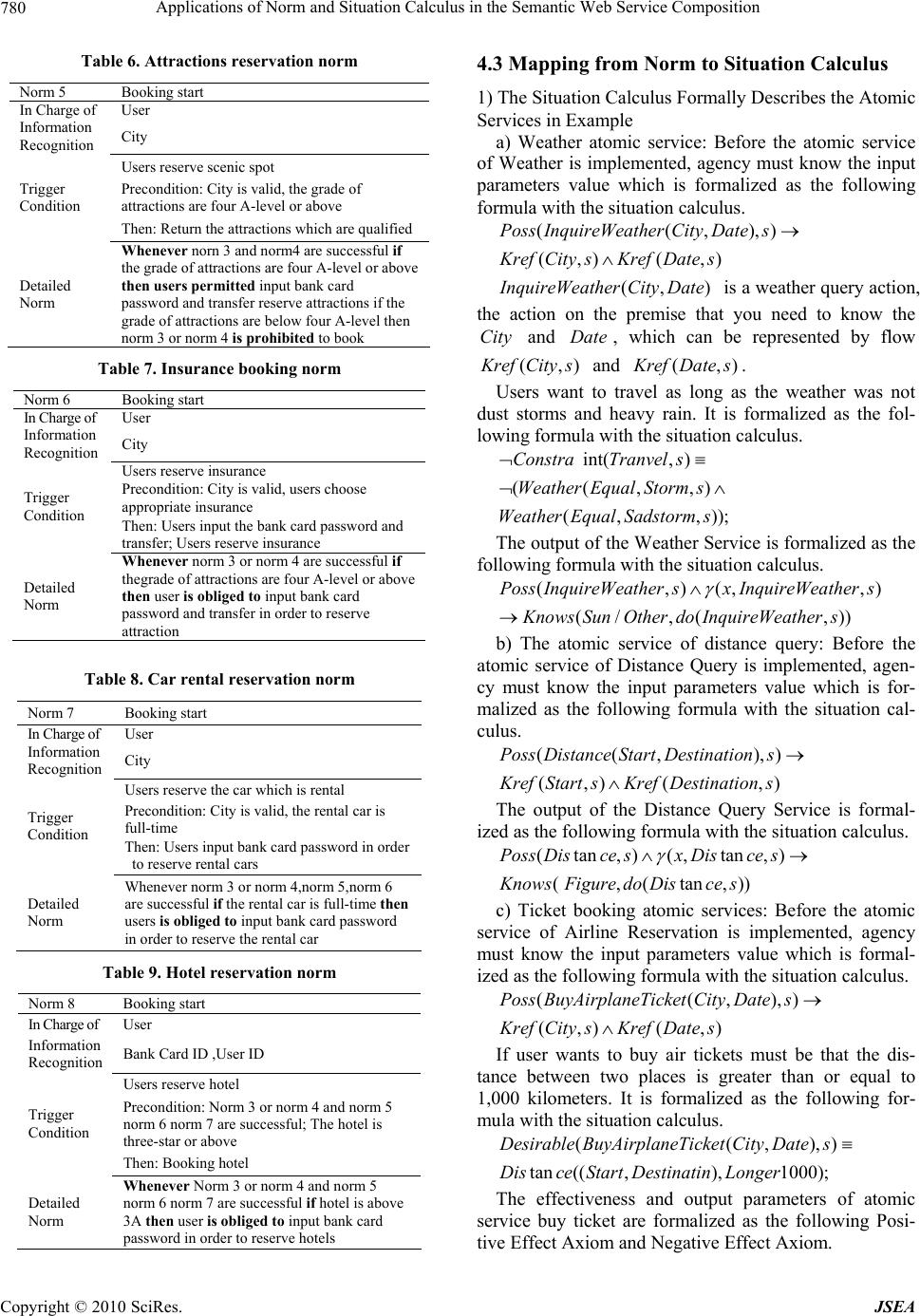 Applications of Norm and Situatio n Calcu lus in the Semantic Web Service Composition 780 Table 6. Attractions reservation norm Norm 5 Booking start In Charge of User Information Recognition City Users reserve scenic spot Precondition: City is valid, the grade of attractions are four A-leve l or above Trigger Condition Then: Return the attrac tions which are qualified Detailed Norm Whenever norn 3 and norm4 are success f u l if the grade of attractions are four A-level or above then users permitted input bank card password and transfer reserve attractions if the grade of attractions are below fou r A-level then norm 3 or norm 4 is prohibited to book Table 7. Insurance booking norm Norm 6 Booking start In Charge of User Information Recognition City Users reserve insurance Precondition: City is valid, user s c ho os e appropriate insurance Trigger Condition Then: Users input the bank card password and transfer; Users reserve insurance Detailed Norm Whenever norm 3 or norm 4 are successful if thegrade of attractions are four A-level or above then user is obliged to input bank card password and transfer in order to reserve attraction Table 8. Car rental reservation norm Norm 7 Booking start In Charge of User Information Recognition City Users reserve the car which is rental Precondition: City is valid, the rental car is full-time Trigger Condition Then: Users input bank card password in order to reserve rental cars Detailed Norm Whenever norm 3 or n o rm 4,norm 5 , no r m 6 are successful if the rental car is full-time then users is obliged to input bank car d pa s sw o rd in order to reserve the rental car Table 9. Hotel reservation norm Norm 8 Booking start In Charge of User Information Recognition Bank Card ID ,User ID Users reserve hotel Precondition: Norm 3 or n orm 4 and norm 5 norm 6 norm 7 are successful; The hotel is three-star or above Trigger Condition Then: Booking hotel Detailed Norm Whenever Norm 3 or norm 4 a nd n orm 5 norm 6 norm 7 are successful if hotel is above 3A then user is obliged to input bank card password in order to reserve hotels 4.3 Mapping from Norm to Situation Calculus 1) The Situation Calculus Formally Describes the Atomic Services in Example a) Weather atomic service: Before the atomic service of Weather is implemented, agency must know the input parameters value which is formalized as the following formula with the situation calculus. ((,Poss InquireWeather City Dates),) ) (,)( , K refCity sKrefDates (, ) I nquireWeather CityDate ty Date (,) is a weather query action, the action on the premise that you need to know the and , which can be represented by flow Ci K refCity s(, and ) K refDate s. Users want to travel as long as the weather was not dust storms and heavy rain. It is formalized as the fol- lowing formula with the situation calculus. int(, )ConstraTranvel s ((,,WeatherEqualStorm s) (, ,)WeatherEqualSadstorms ); ,) The output of the Weather Service is formalized as the following formula with the situation calculus. (,)(,Poss InquireWeather sx InquireWeather s (/ ,(,)) K nows SunOther do InquireWeathers b) The atomic service of distance query: Before the atomic service of Distance Query is implemented, agen- cy must know the input parameters value which is for- malized as the following formula with the situation cal- culus. ((, ),)Poss Distance StartDestinations (,) (,) K refStartsKrefDestinations The output of the Distance Query Service is formal- ized as the following formula with the situation calculus. (tan,)(,tan,)Poss DiscesxDisces ( ,(tan,)) K nowsFigure doDisce s c) Ticket booking atomic services: Before the atomic service of Airline Reservation is implemented, agency must know the input parameters value which is formal- ized as the following formula with the situation calculus. ((,PossBuyAirplaneTicket CityDates),) ) (,)( , K refCity sKrefDates If user wants to buy air tickets must be that the dis- tance between two places is greater than or equal to 1,000 kilometers. It is formalized as the following for- mula with the situation calculus. ((,DesirableBuyAirplaneTicket CityDates),) tan ((,),1000);DisceStart DestinatinLonger The effectiveness and output parameters of atomic service buy ticket are formalized as the following Posi- tive Effect Axiom and Negative Effect Axiom. Copyright © 2010 SciRes. JSEA  Applications of Norm and Situatio n Calcu lus in the Semantic Web Service Composition 781 :( FaBuyAirplaneTicket CityDate ,) ) (, I nstockAirplaneTicket CityDate (,)( ,)Poss asaBuyAirplaneTicket CityDate (, ) InstockAirplaneTicket CityDate (,ownAirplaneTicketdoa s(,)) 2) The Situation Calculus Formally describes the Composition Services in Example The Example involve several combination services: is composed of the Distance Query Service, ticket booking service and ticket reservation service, which implement are controlled mainly by if control operator; BookTi cket J ourney is composed of the Attractions Res- ervation Service; Insurance Booking Service and Car Rental Reservation Service, which implement are con- trolled mainly by A nyordered Tranvel BookTi cket control operator; The composition service is composed of the com- position service; composition service J ourney and Hotel Reservation Service, which imple- ment are controlled mainly by C control op- erator. ondition a) Composition service: Distance Query Service, ticket booking service and ticket reservation service is composed, which implement are controlled mainly by control operator. BookTi cket okTicketBo if The prerequisite was formalized as the following for- mula in the situation calculus: ((1000 , K nows Overkm (tan(,), ))do InquireDisceStartDestinations ((,PossBuyAirplaneTicket CityDates),) (,((, ),)))Knows Sun doInquireWeather CityDates ((1000 , K nows Belowkm (tan(,), ))do InquireDisceStartDestinations ((,PossBuyTrainTicket CityDates),) (,((,), ))); K nows Sun do InquireWeather CityDates Before the composition service of is im- plemented, agency must know the input parameters value which is formalized as the following formula with the situation calculus. BookTi cket ((1000 , K nows Overkm (tan(,), ))do InquireDisceStartDestinations ((,PossBuyAirplaneTicket CityDates),) (,)( ,))KrefCity sKrefDates ((1000 , K nows Belowkm (tan(,), ))do InquireDisceStartDestinations ((,PossBuyTrainTicket CityDates),) ) (,)( ,) K refCitysKrefDate s Based on the above two formulas, we can get the Ac- tion Precondition Axiom. ((1000 , K nows Overkm (tan(,), ))do InquireDisceStartDestinations ((,PossBuyAirplaneTicket CityDates),) (,((, ),))Knows Sun doInquireWeather CityDates (,)( ,))KrefCity sKrefDates ((1000 , K nows Belowkm (tan(,), ))do InquireDisceStartDestinations ((,PossBuyTrainTicket CityDates),) (,((, ),))Knows Sun doInquireWeather CityDates (,)( ,)) K refCity sKrefDates The effectiveness and output parameters of composi- tion service are formalized as the following Positive Ef- fect Axiom and Negative Effect Axiom. 1 :( FaBuyAirplaneTicket City Date ,) (, ) I nstockAirplaneTicket CityDate 2(, )aBuyTrainTicket City Date (, ) I nstockTrainTicket CityDate ((1000 , K nows Overkm ((,do InquireDistanceStartDestinations),)) 11 (,) (,,) F Poss asxas 1 (,(OwnAirplaneTicketdoas ((1000 , ,))) K nows Belowkm ((,do InquireDistanceStartDestinations),)) 22 (,) (,,) F Poss asx as 2 (,(Own TrainTicketdo as ,))) ,) 1 :( FaBuyAirplaneTicket CityDate (,NoInstockAirplaneTicket CityDate) 2(, )aBuyTrainTicket CityDate (,NoInstockTrainTicket CityDate ((1000 , ) K nows Overkm (tan(,), ))do InquireDisceStartDestinations 11 (,) (,,) F Poss asxas 1 (,(OwnAirplaneTicketdo as,))) ((1000 , K nows Belowkm (tan(,), ))do InquireDisceStartDestinations 22 (,) (,,) F Poss asx as 2 (,(, )))Own TrainTicketdo as The output of the Composition Service was formalized as the following formula with the situa- tion calculus. BookTi cket ((1000 , K nows Overkm Copyright © 2010 SciRes. JSEA 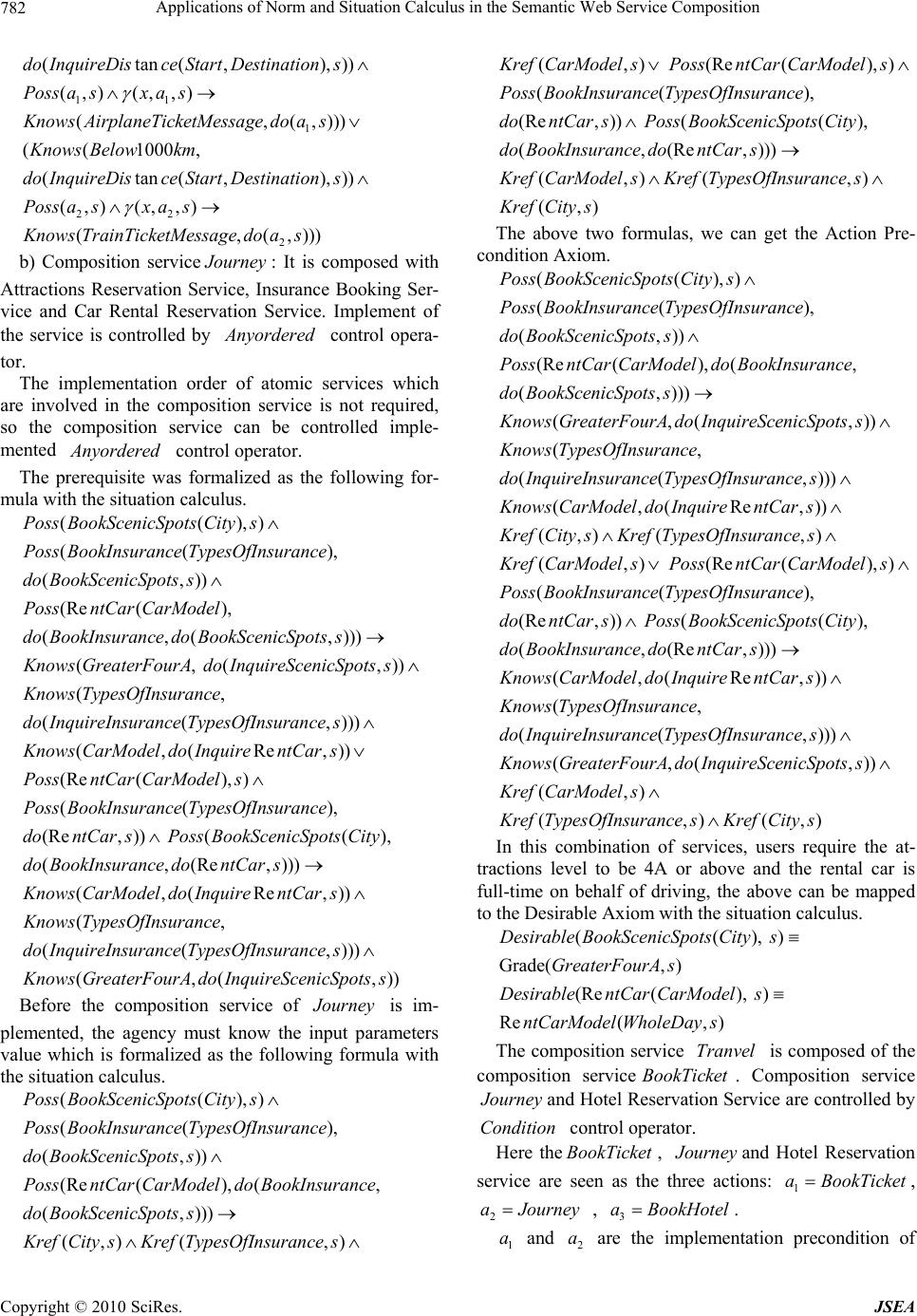 Applications of Norm and Situatio n Calcu lus in the Semantic Web Service Composition 782 (tan(,), ))do InquireDisceStartDestinations 11 (,) (,,)Possa sxa s 1 (,(, )))KnowsAirplaneTicketMessagedo as ((1000 , K nows Belowkm (tan(,), ))do InquireDisceStartDestinations 22 (,) (,,)Possa sxa s 2 (,(,))) K nows TrainTicketMessagedoas b) Composition service J ourney : It is composed with Attractions Reservation Service, Insurance Booking Ser- vice and Car Rental Reservation Service. Implement of the service is controlled by A nyordered control opera- tor. The implementation order of atomic services which are involved in the composition service is not required, so the composition service can be controlled imple- mented A nyordered control operator. The prerequisite was formalized as the following for- mula with the situation calculus. ((PossBookScenicSpotsCitys),) ), )) ))) ((PossBookInsurance TypesOfInsurance (,do BookScenicSpots s (Re (), PossntCar CarModel (,(,do BookInsurancedo BookScenicSpots s (, K nows GreaterFourA(,do InquireScenicSpots s)) (, K nows TypesOfInsurance ((doInquireInsurance TypesOfInsurances,))) (,(Re,Knows CarModeldoInquirentCars)) ), ), )) (Re(), )PossntCar CarModels ((PossBookInsurance TypesOfInsurance (Re, ))dontCar s((PossBookScenicSpots City (,(Re, )))doBookInsurance dontCars (,(Re,Knows CarModeldoInquirentCars (, K nows TypesOfInsurance ((doInquireInsurance TypesOfInsurances,))) (,( ,)) K nowsGreaterFourA doInquireScenicSpotss Before the composition service of J ourney is im- plemented, the agency must know the input parameters value which is formalized as the following formula with the situation calculus. ((PossBookScenicSpotsCitys),) ), )) ((PossBookInsurance TypesOfInsurance (,do BookScenicSpots s (Re(), (,PossntCar CarModeldo BookInsurance (, )))do BookScenicSpots s (,) (,) K refCitysKrefTypesOfInsurance s (,) K refCarModel s(Re(),)PossntCar CarModels ((PossBookInsurance TypesOfInsurance), (Re, ))dontCar s ((PossBookScenicSpots City), ) (,(Re, )))doBookInsurance dontCars (,)(, K refCarModelsKrefTypesOfInsurance s (,) K refCity s The above two formulas, we can get the Action Pre- condition Axiom. ((PossBookScenicSpotsCitys),) ), )) ((PossBookInsurance TypesOfInsurance (,do BookScenicSpotss (Re(), (,PossntCar CarModeldo BookInsurance (, )))do BookScenicSpots s (,(Knows GreaterFourA doInquireScenicSpotss,)) (, K nows TypesOfInsurance ((doInquireInsurance TypesOfInsurances,))) (,(Re,Knows CarModeldoInquirentCars)) (,) (,) K refCitysKrefTypesOfInsurance s (,) K refCarModel s(Re(),)PossntCar CarModels ((PossBookInsurance TypesOfInsurance), (Re, ))dontCar s ((PossBookScenicSpots City), )) (,(Re, )))doBookInsurance dontCars (,(Re,Knows CarModeldoInquirentCars (, K nows TypesOfInsurance ((doInquireInsurance TypesOfInsurances,))) (,(Knows GreaterFourA doInquireScenicSpotss,)) (,) K refCarModel s (,)(,) K refTypesOfInsurance sKrefCitys In this combination of services, users require the at- tractions level to be 4A or above and the rental car is full-time on behalf of driving, the above can be mapped to the Desirable Axiom with the situation calculus. ((DesirableBookScenicSpots Citys), ) Grade(, )GreaterFourA s (Re(), )DesirablentCar CarModels Re(, )ntCarModel WholeDays The composition service is composed of the composition service. Composition service Tranvel icketBookT J ourney Condition and Hotel Reservation Service are controlled by control operator. Here the , BookTi cket J ourney and Hotel Reservation service are seen as the three actions: , 1 a BookTicket 2 aJourney , 3 a BookHotel . 1 a and are the implementation precondition of 2 a Copyright © 2010 SciRes. JSEA 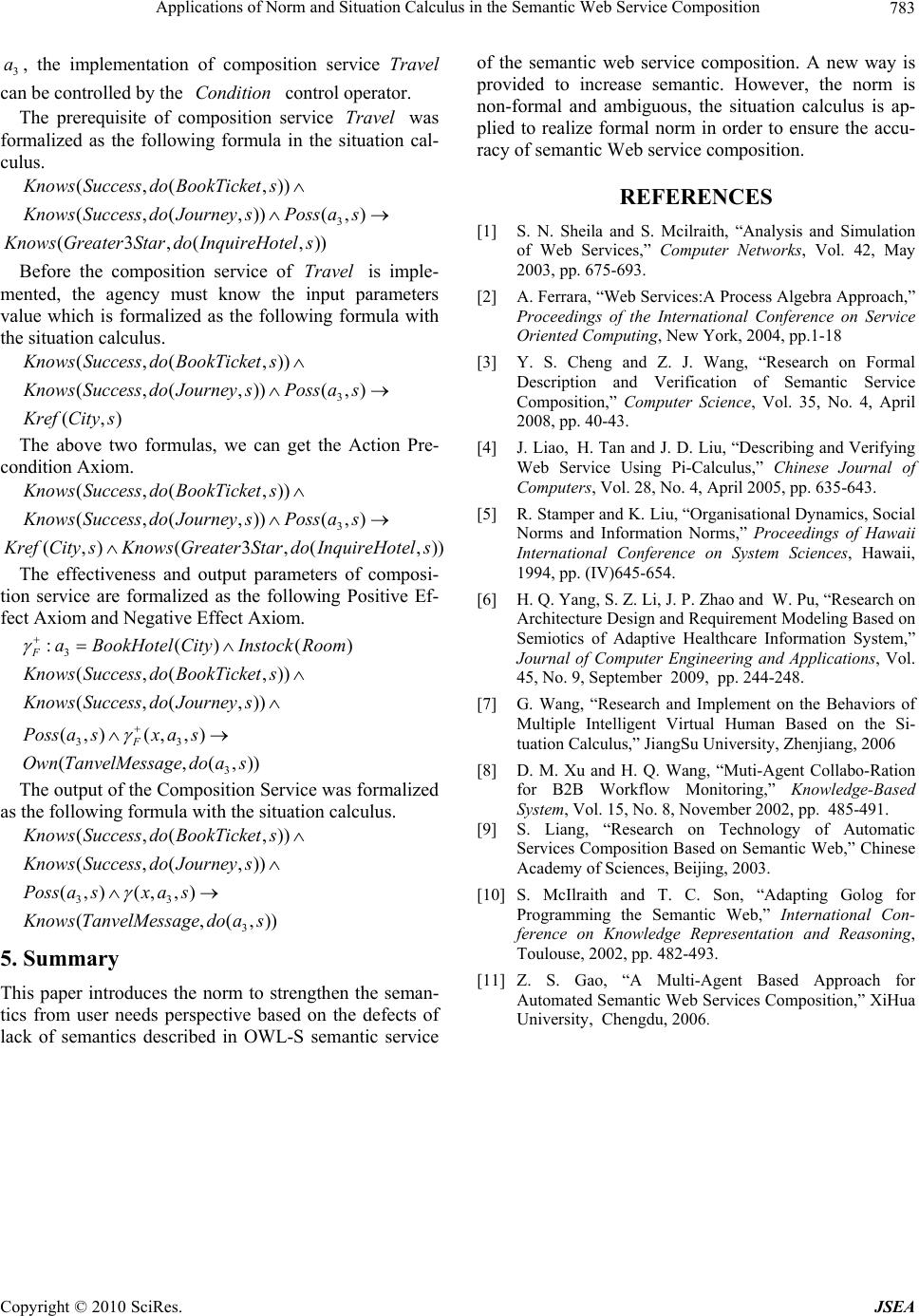 Applications of Norm and Situatio n Calcu lus in the Semantic Web Service Composition Copyright © 2010 SciRes. JSEA 783 ) 3 a, the implementation of composition service Travel can be controlled by the control operator. Condition (ookTicket s (,ourney s ,( The prerequisite of composition service was formalized as the following formula in the situation cal- culus. Travel (, ,)Knows Success do B 3 (, ))(,)Knows Success doJPoss as (3 ,)) K nows GreaterStardotelsoInquireH (ookTicket s (,ourney s Before the composition service of is imple- mented, the agency must know the input parameters value which is formalized as the following formula with the situation calculus. Travel (, ,)Knows Success do B) ) 3 (, ))(,)Knows Success doJPoss as (, K refCity s The above two formulas, we can get the Action Pre- condition Axiom. (, ,)Knows Success do B(ookTicket s (,ourney s ( 3 ) 3 (, ))(,)Knows Success doJPoss as (,),(,)) K refCity sKnowsdo InquireHotGreater Star )City Instock (ookTicket s (,ourney s ,) s 3 (do as (ookTicket s (,ourney s ) el s The effectiveness and output parameters of composi- tion service are formalized as the following Positive Ef- fect Axiom and Negative Effect Axiom. 3 :(( Fa BookHotelRoom ) ) ) ,)) ) ) (, ,)Knows Success do B (, )Knows Success doJ 33 (,) (, F Poss asxa (,OwnTanvelMessage The output of the Composition Service was formalized as the following formula with the situation calculus. (, ,)Knows Success do B (, )Knows Success doJ 33 (,) (,,Possa sxa s 3 (, (,)) K nows TanvelMessagedoas 5. Summary This paper introduces the norm to strengthen the seman- tics from user needs perspective based on the defects of lack of semantics described in OWL-S semantic service of the semantic web service composition. A new way is provided to increase semantic. However, the norm is non-formal and ambiguous, the situation calculus is ap- plied to realize formal norm in order to ensure the accu- racy of semantic Web service composition. REFERENCES [1] S. N. Sheila and S. Mcilraith, “Analysis and Simulation of Web Services,” Computer Networks, Vol. 42, May 2003, pp. 675-693. [2] A. Ferrara, “Web Services:A Proc ess Alge bra Approach,” Proceedings of the International Conference on Service Oriented Computing, New York, 2004, pp.1-18 [3] Y. S. Cheng and Z. J. Wang, “Research on Formal Description and Verification of Semantic Service Composition,” Computer Science, Vol. 35, No. 4, April 2008, pp. 40-43. [4] J. Liao, H. Tan and J. D. Liu, “Describing and Verifying Web Service Using Pi-Calculus,” Chinese Journal of Computers, Vol. 28, No. 4, April 2005, pp. 635-643. [5] R. Stamper and K. Liu, “Organisational Dynamics, Social Norms and Information Norms,” Proceedings of Hawaii International Conference on System Sciences, Hawaii, 1994, pp. (IV)645-654. [6] H. Q. Yang, S. Z. Li, J. P. Zhao and W. Pu, “Research on Architecture Design and Requirement Modeling Based on Semiotics of Adaptive Healthcare Information System,” Journal of Computer Engineering and Applications, Vol. 45, No. 9, September 2009, pp. 244-248. [7] G. Wang, “Research and Implement on the Behaviors of Multiple Intelligent Virtual Human Based on the Si- tuation Calculus,” JiangSu University, Zhenjiang, 2006 [8] D. M. Xu and H. Q. Wang, “Muti-Agent Collabo-Ration for B2B Workflow Monitoring,” Knowledge-Based System, Vol. 15, No. 8, November 2002, pp. 485-491. [9] S. Liang, “Research on Technology of Automatic Services Composition Based on Semantic Web,” Chinese Academy of Sciences, Beijing, 2003. [10] S. McIlraith and T. C. Son, “Adapting Golog for Programming the Semantic Web,” International Con- ference on Knowledge Representation and Reasoning, Toulouse, 2002, pp. 482-493. [11] Z. S. Gao, “A Multi-Agent Based Approach for Automated Semantic Web Services Composition,” XiHua University, Chengdu, 2006. |

